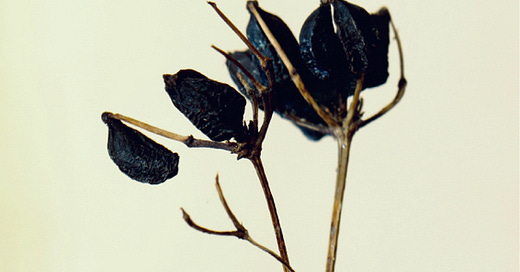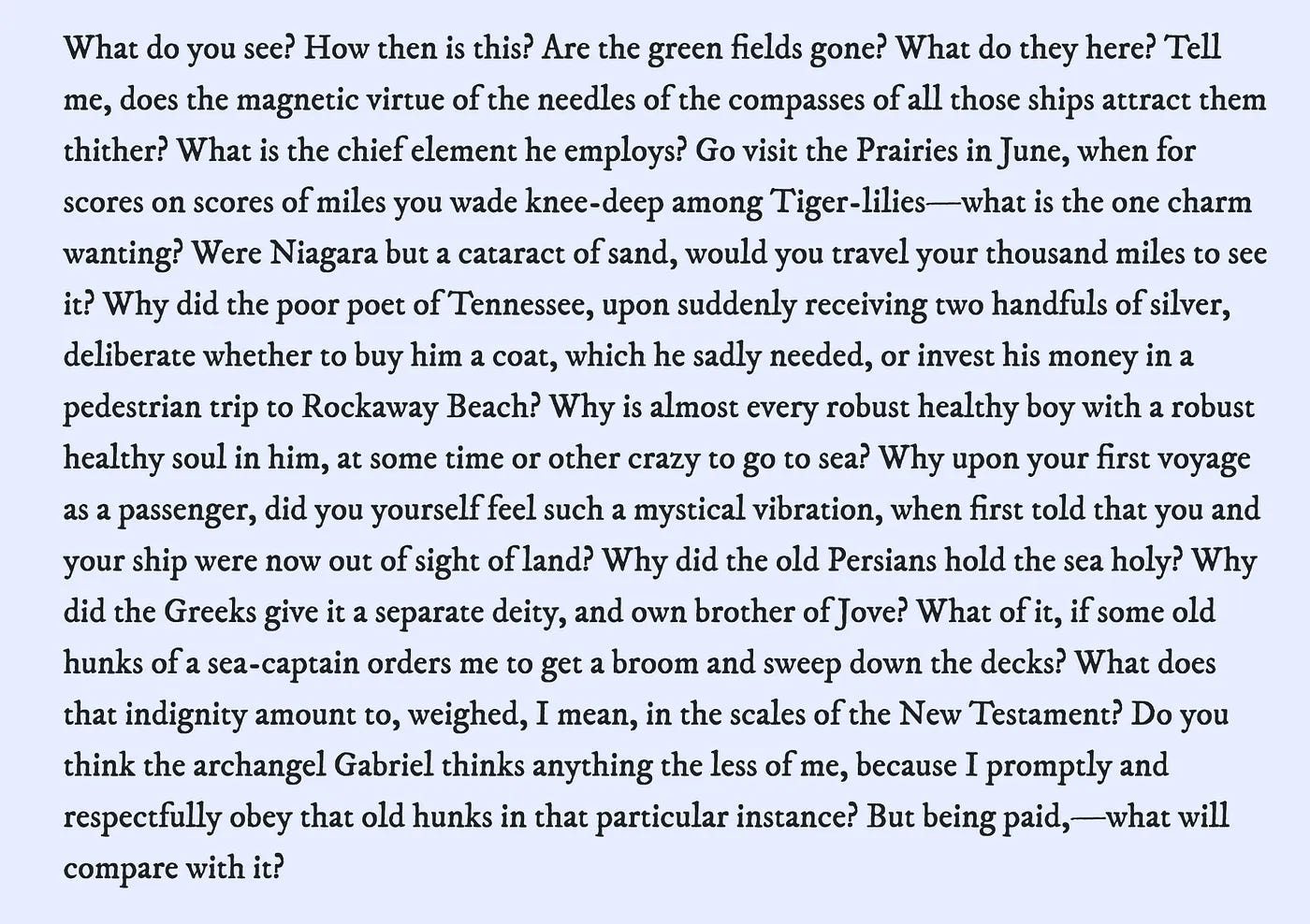Looking For The Answer Inside Your Question
Essay in 12 Steps | TWO | "Without a question we are forever shut out of the inner life of one another." ~Paul Matthews
It was Rumi who said—inspiring the headline for this post, “Look for the answer inside your question.” Could there be a quote more apropos to essay writing, especially lyric essay writing? Probably not.
And speaking of the lyric essay and the Essay in 12 Steps Challenge … it’s week two already!
You have tolerated some discomfort of uncertainty while working with me to look closely at the world—more closely than is probably customary or painless for most of us. For seven straight days, we’ve felt our way along, noticing what catches our attention—those flickers of movement on the periphery, glints of light spilling across the surface. We’ve described these shimmers and shards using concrete, objective language that observes without judging or analyzing, and especially without narrating or story-making. We have stepped back from habit and trusted instead in the quest to see just how “close up to the world” we can get with our words.
And did we? Did we get close up? Did we crawl under the skin of the world and feel its bony protrusions, its rough patches, its soft underbelly?
It seems to me we must have, based not only on the shimmers and shards you shared, but also based on your insightful comments and questions.
We’ve also tried to step back from our “skillfulness” with language (we are so skillful, it’s true, but we already know that; this challenge is for knowing something else, something deeper, something outside of ourselves). We’ve refrained from applying words quickly as a way to impose our own meaning on the world (versus doing the slower work of discovering meaning in the outer world, which are two very different gestures). We’ve attempted to look with great curiosity at the thing itself and describe it in plain language—no comparisons, no metaphors, no story. And we’ve cheered each other on, answered each other’s questions, and inspired one another to look harder, longer, more. And to not know. To wonder.
You’ve told me it’s been hard but also exhilarating. That it’s changed your orientation to everyday life. One writer said:
“This is SO good for my mental health, all those other voices that usually appear while I’m writing and have even made me quit for months at a time—those voices STOP for a minute or two—and this feels miraculous today.”
By the way, here is where I say that if you have not joined us yet and want to, you can absolutely access the numbered prompts in the archive and work at your own pace. You are never too late. Last week’s prompt (and the nearly 200 comments and questions in response to it!) is here.
A quick word about those almost 200 comments (and the auxiliary buzz in Shimmers & Shards, the Writing in the Dark chat): I promise that throughout the 12 weeks of this essay challenge, I will continue to participate in the comments and chat to give direct feedback to your submissions.
So far, you’ve said that’s been valuable, and I am happy to do it! With the necessary disclaimer that if, based on volume of comments, I cannot give direct feedback to every single submission, I’ll prioritize by answering every individual at least once in the course of the week (so if you submit your work examples several times during week two and beyond—and please do! I love the bustling conversation!—I may be able to provide feedback only once).
As for your questions, I’ll keep answering those, too. Sometimes several writers ask similar questions, in which case I might give one answer that addresses several overlapping queries. Therefore, I strongly recommend that all participants at least skim the comments and chat even if you don’t post there, because the ongoing discussion is a dynamic, detailed, and illuminating extension of the weekly posts—and a huge added value you don’t want to miss!
Meanwhile, to launch week two of the Essay in 12 Steps, we turn not to Annie Ernaux and “flat writing,” as I suggested in yesterday’s post that we would (I’m so sorry! We will be discussing Erneaux, but not quite yet! Don’t be mad at me, it’s coming, I promise). Instead, this week’s structured exercise builds on your collection of shimmers/shards from last week, while also playing with the concept of the question. We also explored the question in the 30-Day Creativity Challenge—so, for some of you, this will be an opportunity to go deeper with that questioning energy.
Here’s an excerpt from my April essay on questions:
If you’ve never pondered the power of the question as an integral tool in writing, consider this passage written by the daughter of the Swiss psychologist Jean Piaget:
Where does that little baby come from? I don’t know. Out of the wood. Are you dust before you are born? Are you nothing at all? Are you air? Babies don’t make themselves, they are air. Eggshells make themselves in hens. I think they are air too. Pipes, trees, eggshells, clouds. The door. They don’t make themselves. They have to be made. I think trees make themselves and suns too. In the sky they can easily make themselves. How is the sky made? I think they cut it out. It’s been painted.
If you’re intrigued by the power of the questions asked by Piaget’s daughter, consider this fabulous tool made by Clive Thompson, which isolates the questions in any piece of writing. Below is what Thompson’s tool came up with for all the questions in the first chapter of Moby Dick:
The very word “question” implies a quest, writes Paul Matthews in his unusual and potent craft book, Sing Me the Creation. Matthews goes on to say:
Without a question we are forever shut out from the inner life of one another. In coming to the question we leave the firm ground of the statement behind and trust ourselves to the in-betweens, for the question is nothing if not open and receptive. This is the ideal it strives for.
In this sense, the question must be, perhaps by far, the most creative of the four sentence types.
So, in this week’s essay step two, you will not only be guided to “live into the questions,” as Rilke suggests we do, but encouraged to construct and chisel specific questions on the path to your lyric essay. What we’re hoping for? To access your more elusive material: the stories that shy from direct sunlight.
For those of you who already know what you want your lyric essay to be about—who already know what you want to explore? That’s wonderful! Just keep your intended topic sitting next to you for now—keep it in your line of vision, within easy reach. You’ll be turning to it soon enough, just not quite yet.
First, we must consider our shimmers and shards, turn them over, scatter them on the table, hold them in our palm, scratch at them, pull on them, shuffle them, toss them into the air and let them fall at our feet. We must muse, wonder, search, and yearn.
After all, the word “essay” derives from the French infinitive essayer, “to try” or “to attempt” and in English essay first meant “a trial” or “an attempt.” This etymology suggests that our essays are “tries, trials, attempts, experiments,” all of which are in direct conversation with the heart of what it means to question. To “essay” as a verb, we must question—and not just “ask a question” for the sake of answering it. We must, instead, with our whole being, truly question.
Here’s how we’ll begin to do that.










